![]()
| Xinjiang, China | Kashgar | 2002.08.02 - 08.04 |
Sunday Market
Kashgar was once an important haven on the Silk Road between the snowcapped mountains to the south and west and the scorching desert to the north and east. Today the city still plays an important role as the overland junction between China, Pakistan, and Kyrgyzstan. Travelers and tradesmen crossing the 4800-meter high Pakistani-Chinese Khunjerab Pass on the Karakoram Highway and the 3752-meter high Kyrgyz-Chinese Torugart Pass stop here. Kashgar is remarkably large and thriving for its remoteness. The ethnic mix of Uyghurs, Tajiks, Kyrgyz, and Uzbeks give Kashgar a Central Asian flavor.
SUNDAY MARKET
Most visitors come to Kashgar for the Sunday Market. Pakistani tradesmen cram the budget hotels.
By sunrise, the streets are alive with activity. The central market area is packed with
clothing, carpets, food, live animals, cookware, and tourist souvenirs. Some of the more
interesting market sites are pictured below.
ABAKH HOJA TOMB
Turkic tombs dot the Kashgar area. We enjoyed Abakh Hoja. Colorful tile decorates the central burial
dome exterior. Intricately carved colorful wooden pillars support the rooftops of surrounding
rectangular structures.
City bus 20 (¥1) travels from city center to the Abakh Hoja entrance. Alternatively, a taxi costs a maximum of ¥10 from anywhere in the city. Admission is ¥15. Student discounts are not given.
GETTING TO KASHGAR
Overland, Kashgar is distant from every access point. The fastest way is by express
train from Turpan (22 hours) or Ürümqi (24 hours). The one-way fare for
hard-sleeper is about ¥420 and for soft-sleeper is about ¥520. The most
luxurious sleeping berths on this train are soft-sleeper beds 37~50. Each is in a
private compartment of 2 beds and cost ¥522. The other common overland routes are
by private 4WD from Pakistan (2 days minimum) and Bishkek, Kyrgyzstan (2 days). Both
routes are said to be spectacular, but have 2 caveats. 1) The passes at the borders are only
open in the summer months and 2) visas cannot be obtained at the borders.
Sleeping berth differences on trains K887 / K888:
By air, the only flight is between Kashgar and Ürümqi. Standard one-way fare is ¥980, but discounts are given with advance purchase. 3 days in advance, the ¥980 fare drops to ¥790. Greater discount is given for each day over 3 in advance. The maximum discount is for 9 days in advance - airfare drops to ¥360, becoming cheaper than a hard-sleeper berth on the train.
CHINA TO TURKIC LANDS
In Turpan we learned that Japanese can now enter Kyrgyzstan without a visa. Later
in Kashgar we learned that Americans can get a Kyrgyz visa on arrival, but only by flying
into Bishkek. While many of the former Soviet Republics retain horrifically complicated
bureaucratic procedures regulating travel, Kyrgyzstan (along with the Baltic States) is
relaxing past restrictions. Bordering China to the west, Kyrgyzstan is now the easiest
country to enter. Furthermore, it's an interesting-looking place with bountiful natural
scenery. Had we known earlier, it would have been best for Wes to apply for a Kyrgyz
visa in Beijing. Then we could have joined other tourists in Kashgar for a 4WD trip
over the Torugart Pass to Bishkek. Without the visa, Wes is forced to travel 24 hours by
train to Ürümqi and buy a plane ticket from there to Bishkek.
In Kyrgyzstan, we can apply for an Uzbek visa, and in Uzbekistan maybe we can get a Tajik visa. If these successive visas are granted, we should have an interesting enough experience in Central Asia not to mind sacrificing our intended travels to the Baltics, Poland, Slovakia, Slovenia, and Corsica.
Turkic Lands = Kazakhstan, Kyrgyzstan, Tajikistan, Uzbekistan, Turkmenistan.
| 1400 km of changing scenery from Turpan to Kashgar. | |
 |
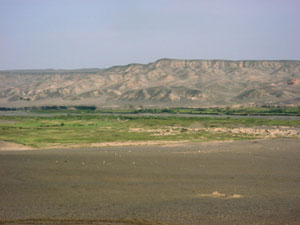 |
| Ugly gray desolate desert stretches from Dunhuang to several hundred kilometers west of Turpan. | Continuing west from the gray desert, greenery sprouts from riverbeds. |
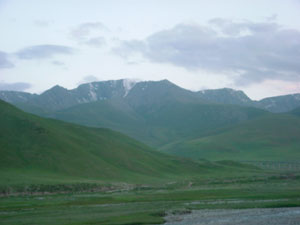 |
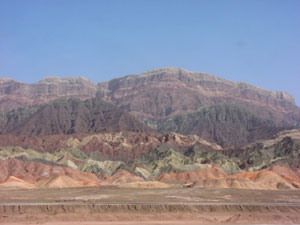 |
| 6 hours after departing Turpan (elevation 175 meters), the train climbs to grasslands (elevation 2960 meters) spotted with snowcapped peaks. | Descending into the west side of the Taklamakan Desert, rock and sand reflect beautiful layers of orange, red, and maroon in the morning sun. |
|
|
|
| Kashgar Sunday Market | |
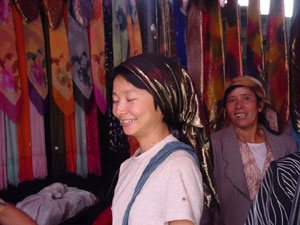 |
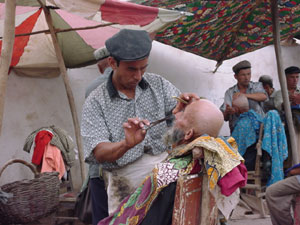 |
| Masami selects a headscarf to prepare for our upcoming journeys through predominantly Muslim territory in the former Soviet Republics (or as the Americans we meet say: Those "-stan" countries). | Need a haircut? For ¥1 (US$0.12) this man will shave your head and face, tidy your beard, trim your nose hairs, and gently massage your temples. We decided to pass. |
 |
 |
| Goat buyers inspect the product's teeth and anus before purchasing. We heard that anus inspection is most important to ensure plentiful butt-fat that is highly sought after - to eat, of course. | A few paces from live goat sales are goat-head eateries. Select the head you wish to eat. A boy will quickly split the scull with a hatchet, boil it in a broth, and serve you lunch. We didn't try, although it looked more palatable than the pig innards and hooves being eaten at a neighboring stall. |
|
|
|
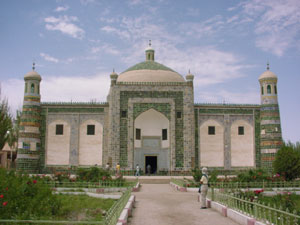 |
The tiled Abakh Hoja Tomb 5km from Kashgar city center is a peaceful visit. Trees line the narrow access road and flowers bloom on the tomb grounds. Wooden and ceramic structures are tastefully aesthetic in blues, greens, and yellows. |
 |
A bookseller adjacent the side entrance to Id Kah Mosque reads the Koran. |
 |
This dentist needs more work on his storefront signage. Does he perform dentistry or just induce pain? |
Copyright © 2000-2002 Wes and Masami Heiser. All rights reserved.